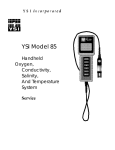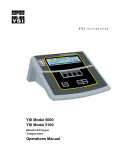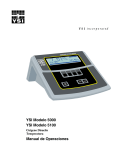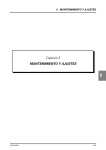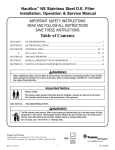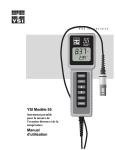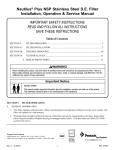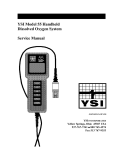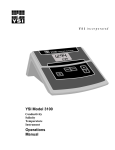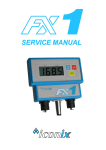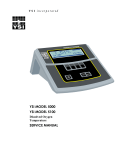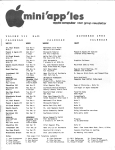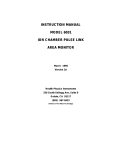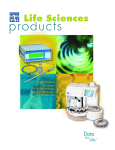Download YSI Model 30 Salinity, Conductivity and
Transcript
YSI Model 30 Salinity, Conductivity and Temperature System Service Manual TABLE OF CONTENTS Section 1 General Description 1 1.1 Service Philosophy 1.2 Specifications 1.3 Principles of Operation 1 2 3 Section 2 Making Measurements 2.1 Advanced Setup 4 6 Section 3 Measurement Errors 8 Section 4 Maintenance 10 Section 5 Instrument Test Procedure 12 Section 6 System Calibration 13 Section 7 Troubleshooting 15 Section 8 Disassembly Procedures 8.1 Assembly Drawing 8.2 Board Assemblies 8.3 Circuit Diagrams 8.4 Feature Customization 16 17 18 19 21 Appendix A Parts List (Board Components) Appendix B Accessories & Replacement Parts Appendix C Warranty and Repair 22 23 24 i ii SECTION 1 GENERAL DESCRIPTION The YSI Model 30 Handheld Salinity, Conductivity and Temperature System is a rugged, microprocessor based, digital meter with an attached YSI four electrode conductivity cell. The YSI Model 30 is designed for use in field, lab, and process control applications and is available with cable lengths of 10, 25 or 50 feet. The body of the probe has been manufactured with stainless steel to add rugged durability and sinking weight. The large liquid crystal display (LCD) is easy to read, and is equipped with a back-light for use in dark or poorly lighted areas. The Model 30's micro-processor allows the system to be easily calibrated with the press of a few buttons. Additionally, the micro-processor performs a self-diagnostic routine each time the instrument is turned on.. The self-diagnostic routine provides you with useful information about the cell constant, function of the instrument circuitry, and the quality of the readings you obtain. For a list of these diagnostic features, see Section 7, Troubleshooting. The system simultaneously displays temperature (oC is factory default, non-CE units can be modified to read in oF, see section 8.4, Feature Customization), along with one of the following parameters: conductivity; temperature compensated conductivity; (in µS/cm or mS/cm), and salinity (in parts per thousand [ppt]). Though calibration is NOT required, a single calibration will adjust the instrument, regardless of which parameter you wish to read. You can switch back and forth from salinity, conductivity, and temperature compensated conductivity with a single push of the MODE key. A probe storage chamber is built into the instrument. This chamber provides a convenient place to store the probe when the system is not in use, and provides protection for the electrodes within the probe. The instrument is powered by six AA-size alkaline batteries. A new set of alkaline batteries will provide approximately 180 hours of continuous operation. When batteries need to be replaced, the LCD will display a "LO BAT" message. The YSI Model 30 instrument case is waterproof (rated to IP65). You can operate your Model 30 in a steady rain without damage to the instrument. 1.1 SERVICE PHILOSOPHY The YSI Model 30 is sold as a complete conductivity measuring system including an attached probe and either a 10, 25 or 50-foot cable. Most service issues that occur in conductivity systems are caused by improper maintenance of the probe and/or cable. For this reason, troubleshooting efforts should be initially directed at determining the condition of the probe and cable. YSI Incorporated Model 30 1 In the event that a service problem is isolated to the meter itself, YSI recommends replacement of the entire defective sub-assembly rather than the individual components. All replacement components are available through YSI; see Appendix C, Warranty & Repair. In most cases, the recommended method of determining a sub-assemblies condition is by substitution. For example ; to test for a defective probe/cable assembly substitute the assembly with a known good assembly or a decade resistance box using Section 5, Instrument Test Procedure. If, after testing, the PCB meets the established specifications, the probe/cable assembly will have to be serviced or replaced. 1.2 SPECIFICATIONS Operating Environment Medium: fresh, sea, or polluted water and most other liquid solutions. Temperature: -5 to +95oC Depth: 0 to 10, 0 to 25, or 0-50 feet (depending on cable length) Storage Temperature: -10 to +50oC Material: ABS, Stainless Steel, and other materials. Dimensions: Height: 9.5 inches (24.13 cm) Thickness: 2.2 inches (5.6 cm) Width: 3.5 inches max. (8.89 cm) Weight: 1.7 pounds (w/ 10’ cable ) (.77 kg) Display 2.3"W x 1.5"L (5.8cmW x 3.8cmL) Power: 9 VDC - 6 AA-size Alkaline Batteries (included) Approximately 180 hours operation from each new set of batteries Water Tightness: Meets or exceeds IP65 standards Extensive testing of the YSI Model 30 indicates the following typical performance: MEASUREMENT Conductivity Salinity Temperature RANGE 0 to 499.9 uS/cm 0 to 4999 uS/cm 0 to 49.99 mS/cm 0 to 200.0 mS/cm 0-80 ppt -5 to 95o C *23 to 203 o F RESOLUTION 0.1 uS/cm 1.0 uS/cm .01 mS/cm 0.1 mS/cm .1 ppt 0.1o C ACCURACY ± .5% FS ± .5% FS ± .5% FS ± .5% FS ± 2%, or ± 0.1ppt ± 0.1o C ( ± 1lsd) * oC is factory default, non-CE units can be modified to read in oF, see section 8.4, Feature Customization. Adjustable Reference Temperature : 15o C - 25o C YSI Incorporated Model 30 2 Adjustable Temperature Compensation Factor: 0% - 4% Temperature Compensation: Automatic Range: User selected or Autoranging 1.3 PRINCIPLES OF OPERATION The Model 30 utilizes a cell with four pure nickel electrodes for the measurement of solution conductance. Two of the electrodes are current driven, and two are used to measure the voltage drop. The measured voltage drop is then converted into a conductance value in milli-Siemens (millimhos). To convert this value to a conductivity (specific conductance) value in milliSiemens per cm (mS/cm), the conductance is multiplied by the cell constant that has units of reciprocal cm (cm-1). The cell constant for the Model 30 conductivity cell is 5.0/cm + 4%. This constant is automatically confirmed each time the instrument is turned on and is determined when the calibration procedure is followed; see section 6, System Calibration. Solutions with conductivities of 1.00, 10.0, 50.0, and 100.0 mS/cm, which have been prepared in accordance with recommendation 56-1981 of the Organization International De Metrologie Legale (OIML)) are available from YSI. The instrument output is in µS/cm or mS/cm for both conductivity and specific conductance. The multiplication of cell constant times conductance is carried out automatically by the software. TEMPERATURE EFFECT The conductivity of solutions of ionic species is highly dependent on temperature, varying as much as 3% for each change of one degree Celsius (temperature coefficient = 3%/C). In addition, the temperature coefficient itself varies with the nature of the ionic species present. Because the exact composition of a natural media is usually not known, it is best to report conductivity at a particular temperature, e.g. 20.2 mS/cm at 14 C. However, in many cases, it is also useful to compensate for the temperature dependence in order to determine at a glance if gross changes are occurring in the ionic content of the medium over time. For this reason, the Model 30 software also allows the user to output conductivity data in either raw or temperature compensated form. If "Conductivity" is selected, values of conductivity that are NOT compensated for temperature are output to the display. If "Specific Conductance" is selected, the Model 30 uses the temperature and raw conductivity values associated with each determination to generate a specific conductance value compensated to a user selected reference temperature, see Section 2.1, Advanced Setup, between 15 C and 25 C. Additionally the user can select any temperature coefficient from 0% to 4%). Using the Model 30 default reference temperature and temperature coefficient (25 C and 1.91%), the calculation is carried out as in equation (1) below: Specific Conductance (25 C) = Conductivity 1 + TC * (T - 25) As noted above, unless the solution being measured consists of pure KCl in water, this temperature compensated value will be somewhat inaccurate, but the equation with a value of TC YSI Incorporated Model 30 3 = 0.0191 will provide a close approximation for solutions of many common salts such as NaCl and NH4Cl and for seawater. YSI Incorporated Model 30 4 SECTION 2 MAKING MEASUREMENTS The YSI Model 30 is factory calibrated. This means that once you have put batteries in the instrument, you are ready to begin taking readings immediately. TURNING THE INSTRUMENT ON ON/OF Once the batteries are installed correctly, turn the instrument face up and F press: The instrument will activate all segments of the display for a few seconds, which will be followed by a self -test procedure that will last for several more seconds. During this power on self-test sequence, the instruments’ microprocessor is verifying that the instrument is working properly, and will display the cell constant of the probe when the self -test is complete. If the instrument were to detect an internal problem, the display would show a continuous error message on the display. You can discover the meaning of these error messages by consulting Section 7, Troubleshooting. After the self- test procedure is complete the temperature will be displayed in the lower right of the display and the instrument is ready to make a measurement. Simply insert the probe into the liquid sample about which you would like to receive information. It is important that the probe be inserted into the liquid deep enough so that the hole on the side of the probe is completely covered by the liquid. If possible, do not allow the probe to touch the any solid object while you are taking readings; this may effect the reading slightly. Additionally, it is important that there not be any air bubbles around the probe electrodes. To dislodge any bubbles that might have formed, move or shake the probe vigorously several times before recording the measurement. THE MODES OF THE MODEL 30 The Model 30 is designed to provide four distinct measurements: Ø Temperature -- which is always displayed Ø Conductivity -- A measurement of the conductive material in the liquid sample without regard to temperature Ø Specific Conductance -- Also known as temperature compensated conductivity which automatically adjusts the reading to a calculated value which would have been read if the sample had been at 25o C (or some other reference temperature which you choose). See Advanced Setup. Ø Salinity -- A calculation done by the instrument electronics, based upon the conductivity and temperature readings. NOTE: When you turn the Model 30 off, it will “remember” which mode you used last and will return to that mode the next time the instrument is turned on. YSI Incorporated Model 30 5 To choose one of the measurement modes above (temperature is always displayed) simply press and release the key. carefully observe the small legends at the far right side of the MOD LCD. E If the instrument is reading Specific Conductance the large numbers on the display will be followed by either a µ S or an mS. Additionally the small portion of the display will show the oC flashing on and off. 300.1 If the instrument is reading Conductivity the large numbers on the display will be followed by either a µ S or an mS. Additionally the small portion of the display will show the oC NOT flashing. µS 23.4 o C If the instrument is reading Salinity the large numbers on the display will be followed by a ppt. AUTORANGING & RANGE SEARCHING The YSI Model 30 is an autoranging instrument. This means that regardless of the conductivity or salinity of the solution (within the specifications of the instrument) all you need to do to get the most accurate reading is to put the probe in the sample. When you first place the Model 30 probe into a sample or calibration solution, and again when you first remove the probe the instrument will go into a range search mode that may take as long as 5 seconds. During some range searches the instrument display will flash rANG to indicate its movement from one range to another. In addition, the instrument may appear to freeze on a given reading for a few seconds then, once the range is located, will pinpoint the exact reading on the display. DURING MEASUREMENT OPERATION While the instrument is in normal operation mode and you are making measurements, only those keys described above have a defined function. The following keys have no function: Ù Ú During normal operation the ENTER key enables and disables the autoranging feature of the instrument. We recommend that the instrument always be operated using the autoranging feature. See Advanced Setup if you need to switch to manual ranging. YSI Incorporated Model 30 6 2.1 ADVANCED SETUP The default settings of the YSI Model 30 are appropriate for the vast majority of measurement applications. However, some measurement applications require very specific measurement criteria. For that reason, we have made the YSI Model 30 flexible to accommodate these “advanced users.” If, for example, you are using the YSI Model 30 for a process control application that requires that the conductivity readings be compensated to 20 oC instead of 25 oC -- this is the section to read. Or, if your application for the YSI Model 30 involves the salinity measurement of a very specific saline solution, the default temperature coefficient may need to be changed to get the very best measurement of that specific salt. Important: There is never a need to enter Advanced Setup Mode unless your special measurement application calls for a change in reference temperature and or temperature coefficient. Therefore, unless you are certain that your application requires a change to one or both of these criteria, do not modify the default reference temperature (25oC) or the default temperature coefficient (1.91%). CHANGING THE TEMPERATURE COEFFICIENT Follow these steps to modify the temperature coefficient of the Model 30. 1. Turn the instrument on, and wait for it to complete its self test procedure 1. Press and release these two keys at the same Ú time MODE 3. The CAL symbol will appear at the bottom left of the display 4. The large portion of the display will show 1.91 % (or a value set previously using Advanced Setup) 5. Use the up or down arrow keys to change the value to the desired new temperature coefficient 6. Press the ENTER key. The word “SAVE” will flash across the display for a second to indicate that your change has been accepted 7. Press the MODE key to return to normal operation; the CAL symbol will disappear from the display YSI Incorporated Model 30 7 CHANGING THE REFERENCE TEMPERATURE Follow these steps to modify the reference temperature of the Model 30. 1. Turn the instrument on, and wait for it to complete its self test procedure 1. Press and release these two keys at the same Ú time MODE 3. The CAL symbol will appear at the bottom left of the display 4. The large portion of the display will show 1.91 % (or a value set previously using Advanced Setup) 5. Press and release the MODE key; the large portion of the display will show 25.0C (or a value set previously using Advanced Setup) 6. Use the up or down arrow keys to change the value to the desired new reference temperature (any value between 15 oC and 25 oC is acceptable) 7. Press the ENTER key. The word “SAVE” will flash across the display for a second to indicate that your change has been accepted 8. The instrument will automatically return to normal operation mode. CHANGING FROM AUTORANGING TO MANUAL RANGING If your application is easier to perform using a manual range that you select, the YSI Model 30 allows you to turn off the default autoranging feature. While you are making conductivity or temperature compensated conductivity measurements simply press and release the ENTER key. Each additional press of the ENTER key will cycle the Model 30 to a different manual range until you return again to autoranging. Five pushes of the ENTER key will cycle the Model 30 through the four manual ranges and return the instrument to autoranging. Note: You may see an error message in some manual ranges if the manual range selected is not adequate for the sample you are measuring. If this happens, simply press and release the ENTER key again until a range is selected which is suitable for your sample. If you get lost and don’t know if you’re in a manual range or autoranging, simply turn the instrument off and back on. The instrument will always default to autoranging when first turned on. The four ranges of the YSI Model 30 are: Range 1 Range 2 Range 3 Range 4 0 to 499.9 µS/cm 0 to 4999 µS/cm 0 to 49.99 mS/cm 0 to 200.0 mS/cm YSI Incorporated Model 30 8 SECTION 3 MEASUREMENT ERRORS System accuracy for conductivity measurements is equal to the sum of the errors contributed by the environment and the various components of the measurement setup. These include: • • • • • • Instrument accuracy Cell-constant error Solution temperature offset Cell contamination (including air bubbles) Electrical noise Galvanic effects Only the first three are of major concern for typical measurements, although the user should also be careful to see that cells are clean and maintained in good condition at all times. Instrument Accuracy = ± .5% maximum The accuracy specified for the range being used is the worst case instrument error. Cell-Constant Error = ± .5% maximum Although YSI cells are warranted to be accurate to within one percent, you should still determine the exact cell constant of your particular cell. Contamination or physical damage to the cell can alter the cell constant. Performing a calibration will eliminate any error that might arise because of cell constant change. YSI cells are calibrated to within one percent of the stated cell constant at a single point. We consider these products to be usefully linear over most instrument ranges. The cell constant can be calibrated to ±0.35% accuracy with YSI conductivity calibrator solutions. Temperature Error = ± 1% maximum The solution temperature error is the product of the temperature coefficient and the temperature offset from 25°C, expressed as a percentage of the reading that would have been obtained at The error is not necessarily a linear function of temperature. The statement of error is derived from a 25°C temperature offset and a 3%/°C temperature coefficient. Total Error Considering only the above three factors, system accuracy under worst case conditions will be ±2%, although the actual error will be considerably less if recommended and properly calibrated cells and instrument ranges are used. Additional errors, which can essentially be eliminated with proper handling, are described below. YSI Incorporated Model 30 9 Cell Contamination This error is usually due to contamination of the solution being measured, which occurs when solution is carried-over from the last solution measured. Thus, the instrument might be correctly reporting the conductivity seen, but the reading does not accurately represent the value of the bulk solution. Errors will be most serious when low conductivity solutions are contaminated by carryover from high conductivity solutions, and can then be of an order of magnitude or more. Follow the cleaning instructions carefully before attempting low conductivity measurements with a cell of unknown history or one that has been previously used in higher value solutions. An entirely different form of contamination sometimes occurs due to a buildup of foreign material directly on cell electrodes. While rare, such deposits have, on occasion, markedly reduced the effectiveness of the electrodes. The result is an erroneously low conductance reading. Electrical-Noise Errors Electrical noise can be a problem in any measurement range, but will contribute the most error and be the most difficult to eliminate when operating in the lowest ranges. The noise may be either line-conducted or radiated or both, and may require, grounding, shielding, or both. Galvanic and Miscellaneous Effects In addition to the error sources described above, there is another class of contributors that can be ignored for all but the most meticulous of laboratory measurements. These errors are always small and are generally completely masked by the error budget for cell-constant calibration, instrument accuracy, etc. Examples range from parasitic reactances associated with the solution container and its proximity to external objects to the minor galvanic effects resulting from oxide formation or deposition on electrodes. Only trial and error in the actual measurement environment can be suggested as an approach to reduce such errors. If the reading does not change as the setup is adjusted, errors due to such factors can be considered too small to see. YSI Incorporated Model 30 10 SECTION 4 MAINTENANCE CLEANING AND STORAGE The single most important requirement for accurate and reproducible results in conductivity measurement is a clean cell. A dirty cell will change the conductivity of a solution by contaminating it. Note: ALWAYS RINSE THE CONDUCTIVITY CELL WITH CLEAN WATER AFTER EACH USE. To clean the conductivity cell: 1. Dip the cell in cleaning solution and agitate for two to three minutes. Any one of the foaming acid tile cleaners, such as Dow Chemical Bathroom Cleaner, will clean the cell adequately. When a stronger cleaning preparation is required, use a solution of 1:1 isopropyl alcohol and 10N HCl. Remove the cell from the cleaning solution. 2. Use the nylon brush (supplied) to dislodge any contaminants from inside the electrode chamber. 3. Repeat steps one and two until the cell is completely clean. Rinse the cell thoroughly in deionized, or clean tap water. 4. Store the conductivity cell in the meter storage chamber. PROBE PRECAUTIONS Observe the following precautions to ensure accurate, repeatable results: 1. The cell must be clean before making any measurements. When working with substances having low conductivity, extraordinary cleanliness may be required. 2. Suspend the cell in the solution deep enough to submerge the vent hole. The electrode chamber should be free of trapped air. You may need to tap the probe gently to dislodge any air bubbles. YSI Incorporated Model 30 11 3. Ideally, the cell should be at least ¼ inch away from any other object, including the sides or bottom of the solution container. 4. Stirring may be necessary for highest accuracy measurements, especially in low-conductivity solutions. 5. If possible, isolate from ground potential the container or system in which measurements are to be made. 6. Electrical fields and stray currents caused by stirrer motors, heaters, etc., can interfere with measurements. The user should determine the effects of these and make the necessary corrections, either by shielding or by disconnecting those units that cause trouble. 7. Always rinse the cell carefully before transferring it from one solution to another. Never store a dirty or contaminated cell. YSI Incorporated Model 30 12 SECTION 5 INSTRUMENT TEST PROCEDURE As stated in Section 1.1, Service Philosophy, the easiest way to troubleshoot the Model 30 is by substitution and process of elimination. Below is a procedure to test the accuracy and function of the electronics portion of the system, minus the cell. If any section of the test fails, the board assembly will have to be repaired or replaced. When disassembled, the keypad function can be simulated by connecting a jumper wire to the DGNG pin of JP3, and momentarily touching the desired pin or pins. 1. Disassemble the instrument 1uF case by following Section 8, Drive 1 1 Disassembly Procedures of Decade Sense 1 this manual. 2 Resistance Box 2. Once the conductivity cell is Sense 2 3 JP1 unplugged from PCB 1uF R1 Drive 2 4 connector JP1, connect a decade resistance box in its RT 1 5 10KΩ place. Reference Figure 1 and RT 2 6 R2 Figure 2. 3. Use either a second decade resistance box or a 10K ohm Probe Model 30 Test Cable resistor to substitute for the Simulators thermistor, RT1 and RT2. This resistance must be substituted Figure 1 or an error we displayed on the LCD. 4. Using Section 6, System Calibration (start at step 7), calibrate to 450.0 µ S using inputs of 11.11 KΩ at R1 and 10.00 KΩ at R2. 5. Use the charts below to test the instrument’s accuracy. Also, check the cell constant by cycling the instrument on an off. It should fall between K = 4.97 and 5.03. In chart 1, the tolerance column reflects the accuracy of the decade resistance box. Conductivity Test (Chart 1) R1 Resistance R2 Resistance 33.330 Ω 10.00 KΩ ±.1% 111.10 Ω 10.00 KΩ ±.1% 1111.0 Ω 10.00 KΩ ±.1% 11.11 KΩ 10.00 KΩ ±.1% YSI Incorporated Decade Tolerance 0.5% 0.2% 0.1% 0.1% Model 30 Nominal Reading 150.0 mS 45.00 mS 4.500 mS 450.0 µS Acceptable Reading 147.2 to 152.8 mS 44.37 to 45.65 mS 4442 to 4560 µS 450.0 µS 13 Temperature Test R2 Resistance 32.66 KΩ ± .1% 10.00 KΩ ± .1% 5329 Ω ± .1% 1752 Ω ± .1% SECTION 6 (Chart 2) Nominal Reading 0.0 oC 25.0 oC 40.0 oC 70.0 oC Pinout JP1 Acceptable Reading 0.0 ± .1 oC 25.0 ± .1 oC 40.0 ± .1 oC 70.0 ± .1 oC SYSTEM CALIBRATION S1 S2 RT2 • • • • • • D1 D2 RT1 PCB End (Bottom) Figure 2 BEFORE YOU CALIBRATE Important: System calibration is rarely required because of the factory calibration of the YSI Model 30. However, after service is performed you should check the system calibration and make adjustments when necessary. To accurately calibrate the YSI Model 30, it is important to remember the following: 1. Always use clean, properly stored, NIST traceable calibration solutions . When filling the clean calibration container prior to performing the calibration procedures, make certain that the level of calibrator buffers is high enough in the container to cover the entire conductivity cell. Gently agitate the probe to remove any bubbles in the conductivity cell. 2. Rinse the probe with deionized water (and wipe dry) between changes of calibration solutions. 3. During calibration, allow the probe time to stabilize with regard to temperature (approximately 60 seconds) before proceeding with the calibration process. The readings after calibration are only as good as the calibration itself. 4. Perform sensor calibration at a temperature as close to 25oC as possible. This will minimize any temperature compensation error. THE CALIBRATION PROCESS System calibration is rarely required because of the factory calibration of the YSI Model 30. However, from time to time it is wise to check the system calibration and make adjustments when necessary. Follow these steps to perform an accurate calibration of the YSI Model 30: 1. Turn the instrument on and allow it to complete its self test procedure 2. Select a calibration solution which is most similar to the sample you will be measuring • • For sea water choose a 50mS/cm conductivity standard (YSI Catalog# 3169) For fresh water choose a 1mS/cm conductivity standard (YSI Catalog# 3167) YSI Incorporated Model 30 14 • For brackish water choose a 10mS/cm conductivity standard (YSI Catalog # 3168) 3. Place at least 3 inches of solution in a clean glass beaker 4. Insert the probe into the beaker deep enough to completely cover the oval shaped hole on the side of the probe. Do not rest the probe on the bottom of the container -- suspend it above the bottom at least 1/4 inch. 5. Allow at least 60 seconds for the temperature reading to become stable 6. Move the probe vigorously from side to side to dislodge any air bubbles from the electrodes 7. Press and release these two keys at the same time Ù Ú The CAL symbol will appear at the bottom left of the display to indicate that the instrument is now in Calibration mode. 10.00 µS 24.8 oC CAL 8. Use the up or down arrow key to adjust the reading on the display until it matches the value of the calibration solution you are using. Once the display reads the exact value of the calibration solution being used (the instrument will make the appropriate compensation for o temperature variation from 25 C) press the ENTER key once. The word “SAVE” will flash across the display for a second indicating that the calibration has been accepted. Note: You must press the up or down arrow key during the calibration process or an error message will appear on the display. If this occurs, turn the instrument off and back on, and begin the calibration procedure again. Also, see Section 7, Troubleshooting. The YSI Model 30 is designed to retain its last calibration permanently. Therefore, there is no need to calibrate the instrument after battery changes or power down. YSI Incorporated Model 30 15 SECTION 7 TROUBLESHOOTING Symptom Possible Cause 1. Instrument will not turn on A. B. C. Low battery voltage Instrument “locked up” Faulty keypad or main PCB 2. Instrument will not calibrate 3. Instrument "locks up" 4. Instrument readings are inaccurate A. B. C. A. B. C. A. B. C. D. E. 5. Main Display reads “OVEr” 6. Main Display reads “Undr” Main Display reads “rErr” Main Display reads “PErr” Main Display reads “LErr” Incorrect calibration procedure Cell needs cleaning Defective cell or main PCB Instrument has rec'd a shock Batteries are low or damaged System requires service Calibration is required Cell is contaminated Tempco has been set incorrectly Reference temperature incorrect Readings are or are not temperature compensated. Conductivity Reading is >200 mS Temp. Reading is > 95o C Temp. Reading is <-5o C Salinity reading is > 80ppt User cell constant cal is >K=5.25 Defective probe/cable assembly User cell constant cal is <K=4.9 Cell is fouled User has selected manual ranging & sample exceeds selected range Incorrect sequence of key strokes 7. 8. 9. A. B. C. D. E. F. A. B. A. A. A. B. 10. Secondary Display reads “Err ra” 11. Secondary Display reads “Err ro” 12. Secondary Display reads “ovr” 13. Secondary Display reads “udr” 14. Secondary Display YSI Incorporated C. A. A. A. B. A. B. A. In temp. comp. cond. mode, temperature exceeds the values computed using user defined tempco & or reference temperature In cell constant cal mode, temperature exceeds the values computed using user defined tempco & or reference temperature Probe thermistor out of specs System has failed its RAM test check procedure System has failed its ROM test check procedure Temperature is > 95o C Probe thermistor out of specs Temperature is < -5o C Probe thermistor out of specs Temperature jumper is set to o F Model 30 Action A. Replace batteries B. Remove battery lid, wait 15 seconds for reset, replace lid C. Trouble shoot or return system for service A. See “Calibration” Sections B. See “Maintenance” Section C. Troubleshoot or return system for service A & B. Remove battery lid, wait 15 seconds for reset, replace lid. C. Return system for service A. See “ System Calibration” Section B. See “Maintenance” Section C. See “Advanced Setup” Section D. See “Advanced E. See “Taking Measurements” Section A - E. In all cases, check calibration values and procedure; check Advanced Setup settings. If each of these is set correctly troubleshoot or return system for service. F. Troubleshoot,replace cell/cable assembly A. Recal using a known good calibrator solution B. Clean cell as described in “Maintenance” Section A. Use the mode key to select a higher or lower manual range, or to set system to Autoranging. A. Refer to manual section which provides step by step procedures for the function you are attempting. A & B. Adjust user defined tempco or reference temperature (Advanced Setup) C. Replace probe /cable assembly A. Turn instrument OFF and back ON or reset. Troubleshoot or return the system for service. A. Turn instrument OFF and back ON or reset. Troubleshoot or return the system for service. A. Read solution of lower temperature B. Replace probe /cable assembly A. Read solution of higher temperature B. Replace probe /cable assembly A. Set jumper to read o C. 16 Symptom reads “rEr” YSI Incorporated Possible Cause o and reading is >199.9 F but < 203 o F Model 30 Action B. Troubleshoot or return system for service 17 SECTION 8 DISASSEMBLY PROCEDURES Refer to the Assembly drawing on the next page before attempting to disassemble the meter case. Follow these steps to disassemble the meter case: STEP 1 -- Place the instrument face down on a flat cloth-covered surface. Use a Phillips screwdriver to completely remove the screw located at the bottom of the hand strap. STEP 2 -- Using a standard screwdriver or a small coin, loosen the battery lid screw and remove the battery lid and all six AA-size batteries. STEP 3 -- With the instrument face down on the flat, cloth-covered surface, place two fingers into the battery chamber and your other hand over the cable strain-relief. Pull straight up on the battery chamber to separate the case halves. Unplug the power connector from the PC Board. NOTE: Because the Model 30 is water tight, the case halves will be relatively difficult to separate. STEP 4 -- The main PC Board is held in place by a single Phillips screw located in the center of the board. Remove the screw, and gently pull the PC Board away from the front case. NOTE: The leads on the cable that connect to the main PC Board are quite short. Be careful not to damage the terminal connectors when you pull the PC Board away from the front case. STEP 5 -- Carefully slide the probe cable terminal connector out of its mating connector. Make note of the wire color configuration so that the connectors can be correctly re-installed later. STEP 6 -- To separate the probe cable from the front case, unscrew the outer portion of the strain relief (that portion which does not make contact with the front case). Slide the spiral portion of the strain relief down the cable toward the probe. Next, unscrew the remaining portion of the strain relief from the front case. STEP 7 -- To separate the LCD from the main PC Board, squeeze the four plastic off-set spacers and slide the LCD PC board away from the main board one corner at a time. Next, remove the four small Phillips screws from the back of the LCD and remove the LCD from its clear plastic frame. STEP 8 -- To remove the keypad from the front case, use a small Phillips screwdriver to remove the screws from the keypad's metal backplate; then lift the keypad away from the front case. YSI Incorporated Model 30 18 8.1 ASSEMBLY DRAWING 1 2 4 3 6 5 4 Bubble YSI Order Number Description 1 2 2 030131 Front Case Assembly, W/Keypad 030133 Board Assembly, 30, With Display, Non-CE Units *030156 Board Assembly, 30, Without Display, CE Units *030898 Board Assembly, Display, 30, CE Boards 3 055242 Rear Case Assembly 4 055204 Kit, Case Hardware 5 055244 Kit, Battery Hardware 6 110030 Probe & Cable Assembly, 10 feet 6 110031 Probe & Cable Assembly, 25 feet 6 110032 Probe & Cable Assembly, 50 feet *Use on Non-CE Instruments. A jumper on #030156 board may need to be moved. Contact YSI. YSI Incorporated Model 30 19 8.2 BOARD ASSEMBLIES MAIN PC BOARD LCD DISPLAY BOARD KEYPAD BOARD Drawings are representative. The actual layout may vary slightly. YSI Incorporated Model 30 20 8.3 CIRCUIT DIAGRAMS MAIN PC BOARD Schematics are representative. The actual circuit may vary slightly. YSI Incorporated Model 30 21 LCD BOARD KEYPAD BOARD PROBE CONNECTOR WIRING Schematics are representative. The actual circuit may vary slightly. YSI Incorporated Model 30 22 8.4 FEATURE CUSTOMIZATION Non-CE Model 30 boards can be setup to display temperature in degrees Fahrenheit or Celsius by moving a single jumper. This applies to Non-CE boards only. Note: To customize a Model 30, the rear cover will have removed and the printed circuit board exposed. For this reason, a qualified service technician should perform this procedure. hhh Jumper used to change temperature from oC to o F. When the jumper is plugged into the right 2 pins, temperature will display in oC. When the jumper is plugged into the left 2 pins, temperature will display in oF. NOTE: FIGURE SHOWN IN DEGREES FAHRENHEIGHT MODE Exposed side of printed circuit board when rear cover is removed. YSI Incorporated Model 30 23 APPENDIX A PARTS LIST (BOARD COMPONENTS) Circuit Symbol Description Circuit Symbol Description JP1 JP2 JP3 JP4 JP5 JP6 J1 R1,R2,R26,R44 R3 R4,R12,R13,R16,R17 R5 R6 R7 R8 R9,R10,R 20 R11 R14,15,35 R18 R19, 24 R21 R22 R23 R25 R27 R28 R29 R30, R36 R31 R32 R33 R34 R37 R38 R39 R40 R41 R42 R43 Conn. 6 pin RT. Conn. 2 Pin Male Conn. 8 Pin Wafer Conn. 4 Pin Wafer Conn. 11 Pin Wafer Conn 11 Pin Conn. 3 Pin Wafer Res. 100K, 5% Res. 33K, 5% Res. 1 Meg, 1% Res. 90.9K, 1% Res. 9.09K, 1% Res, 768, 1% Res. 237, 1% Res. 562K, 1% Res. 100, 5% Res. 10Meg, 1% Res. 3.92K. 1% Res. 1.0K, 1% Res. 28.7K, 1% Res. 10K, 1% Res. 4.22K, 1% Res. 1.50K, 1% Res. 220K, 5% Res. 845K, 1% Res. 232K, 1% Res. 15.0K, 1% Res. 120K, 1% Res. 499K, 1% Res. 301K, 1% Res. 280K, 1% Res. 357K, 1% Res. 15K ,5% Res. 100K, 5% Res. 82, 5% Res. 15, 5% Res. 100, 5% Res. 392K, 1% RN1 C1,C2,C8,C11,C17 C24, C25 C3,C4,C12,C15,C16 C26,C27,C28,C32,C33 C5,C29-C31 C6, C9 C7, C10 C13 C14 C18, 22 C19 C20 C21 C23 D1-D8, D11 D9, D10 D12, D13 D14-D19 U1 U2 U3 U4 U5, U7 U6 U8 U8 U9 U10 U11 U12 U13 U14 U15 U16 Q1, Q2 Q3 X1 Res. SIP, 100K Capr. MPE. 0.1uF 63V Capr. MPE. 0.1uF 63V Capr. Multi. 0.1 uF 50V Capr. Multi. 0.1 uF 50V Capr. Cer. 20pF Capr. MPE. 1uF, 63V Capr. MPE. 10nF, 63V Capr. MPE. .22uF, 63V Capr. PSI. 470pF, 50V Capr. Ele. 100uF, 16V Capr. Multi. .47uF, 50V Capr. Ele. 22uF, 16V Capr. Ele. 10uF, 16V Capr. MPE. .33uF, 63V Diode, 1N4148 Zener Diode, 7.5V Diode 1N4148 LED, HLMP-1540 I.C. LTC1043CN I.C. LF444CN I.C. CD4052BCN I.C. CD4066BE I.C. OP177GP I.C. CD4053BE I.C. S8125OHG I.C. TC4011BP I.C. 7663ACPA I.C. TC7660CPA I.C. TC7660CPA I.C. DC8069 I.C. TC500CPE I.C. S8054ALR I.C. MC68HC711C9CFN I.C. HD61603 Trstr. A1015P, PNP MPSA06 Crystal 4.0M Hz YSI Incorporated Model 30 24 APPENDIX B ACCESSORIES AND REPLACEMENT PARTS The following parts and accessories are available from YSI Customer Service or authorized YSI Dealer. YSI Order Number Description 3166 Resistance Calibrator Set 3161 Conductivity Calibration Solution 1,000 µ/cm (1 Quart) 3163 Conductivity Calibration Solution 10,000 µ/cm (1 Quart) 3165 Conductivity Calibration Solution 100,000 µ/cm (1 Quart) 3167 Conductivity Calibration Solution 1,000 µ/cm (8 pints) 3168 Conductivity Calibration Solution 10,000 µ/cm (8 pints) 3169 Conductivity Calibration Solution 50,000 µ/cm (8 pints) 5520 Carrying Case 110030 Replacement Probe & Cable Assembly (10 feet) 110031 Replacement Probe & Cable Assembly (25 feet) 110032 Replacement Probe & Cable Assembly (50 feet) 030133 Board Assembly, 30, With Display, Non-CE Units 030156 Board Assembly, 30, Without Display, CE Units 030898 Board Assembly, Display, 30, CE Boards 030131 Front Case Cover Assembly, With Keypad 055242 Rear Case Cover 055244 Battery Cover Kit 055204 Case Gasket and Screw 055219 Storage Chamber Sponge 038213 Electrode Cleaning Brush Please note: Only parts with a YSI order number are available from YSI. YSI Incorporated Model 30 25 APPENDIX C WARRANTY AND REPAIR YSI Model 30 Handheld Meters are warranted for two years from date of purchase by the end user against defects in materials and workmanship. YSI Model 30 probes and cables are warranted for one year from date of purchase by the end user against defects in material and workmanship. Within the warranty period, YSI will repair or replace, at its sole discretion, free of charge, any product that YSI determines to be covered by this warranty. To exercise this warranty, write or call your local YSI representative, or contact YSI Customer Service in Yellow Springs, Ohio. Send the product and proof of purchase, transportation prepaid, to the Authorized Service Center selected by YSI. Repair or replacement will be made and the product returned, transportation prepaid. Repaired or replaced products are warranted for the balance of the original warranty period, or at least 90 days from date of repair or replacement. Limitation of Warranty This Warranty does not apply to any YSI product damage or failure caused by (i) failure to install, operate or use the product in accordance with YSI’s written instructions, (ii) abuse or misuse of the product, (iii) failure to maintain the product in accordance with YSI’s written instructions or standard industry procedure, (iv) any improper repairs to the product, (v) use by you of defective or improper components or parts in servicing or repairing the product, or (vi) modification of the product in any way not expressly authorized by YSI. THIS WARRANTY IS IN LIEU OF ALL OTHER WARRANTIES, EXPRESSED OR IMPLIED, INCLUDING ANY WARRANTY OF MERCHANTABILITY OR FITNESS FOR A PARTICULAR PURPOSE. YSI’s LIABILITY UNDER THIS WARRANTY IS LIMITED TO REPAIR OR REPLACEMENT OF THE PRODUCT, AND THIS SHALL BE YOUR SOLE AND EXCLUSIVE REMEDY FOR ANY DEFECTIVE PRODUCT COVERED BY THIS WARRANTY. IN NO EVENT SHALL YSI BE LIABLE FOR ANY SPECIAL, INDIRECT, INCIDENTAL OR CONSEQUENTIAL DAMAGES RESULTING FROM ANY DEFECTIVE PRODUCT COVERED BY THIS WARRANTY. WQ AUTHORIZED U.S. SERVICE CENTERS North Region YSI Incorporated • Repair Center • 1725 Brannum Lane • Yellow Springs, Ohio • 45387 • Phone: (800) 765-4974 • (937) 767-7241• E-Mail: [email protected] South Region C.C. Lynch & Associates • 212 E. 2nd Street • Suite 203 • Pass Christian, Mississippi • 39571 • Phone: (800) 333-2252 • (228) 452-4612 • Fax: (228) 452-2563 West Region EnviroServices & Repair • 1110 Burnett Avenue, Suite D • Concord, CA • 94520 • Phone: (800)550-5875 • Fax: (510)674-8655 Central Region HydroTech Services, LLC • 4910 Iris Street Wheat Ridge, CO• 80033 • Phone: (877) 467-0800 • Fax: (303) 467 0742 • E-Mail: [email protected] YSI Incorporated Model 30 26 INTERNATIONAL SERVICE CENTERS YSI Incorporated • Repair Center • 1725 Brannum Lane • Yellow Springs, Ohio • 45387 • Phone: (937) 767-7241• E-Mail: [email protected] YSI Limited • Lynchford House • Lynchford Lane • Farnborough • Hampshire • GU146LT • Phone: (44-1252) 514711 • Fax: (44-1252) 511855 • Tlx: 858210 YSI Japan • Sakura – Building 6-5-6-13 • Shinjuku, Shinjuku-ku, Tokyo • 160 • Phone: (81-3) 5360-3561 • Fax: (81-3) 5360-3565 SPECIALTY SERVICE CENTERS Aquaculture Aquatic Eco Systems, Inc. • 1767 Benbow Court • Apopka, Florida • Phone: (407) 886-3939 • Fax: (407) 886-6787 Aquacenter • 166 Seven Oaks Road • Leland, Mississippi • 38756 • Phone: (601) 378-2861 • Fax: (601) 378-2862 Wastewater Q.C. Services • P.O. Box 68 • Harrison, Maine • 04040 • Phone: (207) 583-2980 Q.C. Services • P.O. Box 14831 • Portland, Oregon • 97293 • Phone: (503) 236-2712 North Central Labs • 400 Lyons Road • Birnamwood, Wisconsin • Phone: (800) 648-7836 • Fax: (715) 449-24 YSI Incorporated Model 30 27 1700/1725 Brannum Lane Yellow Springs, Ohio 45387 USA (800) 765-4974 (937) 767-7241 FAX: (937) 767-9320 Website: http://www.ysi.com E-mail: [email protected] Item # 030132 Drawing # A30132 Revision C September 1998

































